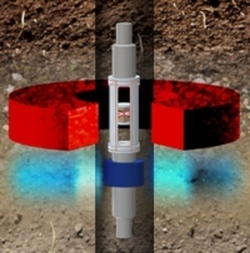
NMR-based measurements of spin relaxation and diffusion are widely used in geochemical logging as a method for identifying the fluids contained in underground reservoirs surrounding a borehole, with applications such as guidance of oil-field drilling. Current NMR logging tools are adapted from conventional high-field NMR techniques, using permanent magnets to increase the magnetic field penetrating into the formation surrounding the borehole, with inductive coils used for detection. However, there are distinct advantages to instead performing these measurements in the ambient Earth’s field, using an atomic magnetometer for detection at the relatively low proton NMR frequency of about 2 kHz. Contrast between the spin relaxation properties of materials is enhanced at very low fields, allowing for oil to be more easily distinguished from other fluids, such as water. In addition, the ex situ fields produced by the permanent magnets located within the borehole are very inhomogeneous and decay rapidly with distance, allowing for detection of thin shells of material within only a few centimeters from the logging tool. In contrast, the Earth’s field can be extremely homogeneous, permitting detection of larger volumes of material deeper into the rock formation.
We have demonstrated the use of an alkali-vapor atomic magnetometer for laboratory measurements of spin relaxation and diffusion in water and hydrocarbons, as a proof-of-principle experiment to demonstrate the viability of applying Earth’s field detection for geochemical logging. We prepolarized samples at 2 Tesla and then shuttled them into the magnetometer, where the spins evolved at the level of the Earth’s field (50 microtesla) and their behavior monitored using the magnetometer. In these experiments, we demonstrated sufficient chemical sensitivity to characterize the components of water/hydrocarbon fluid mixtures, a necessary first step toward the development of tools for use in drilling operations.
